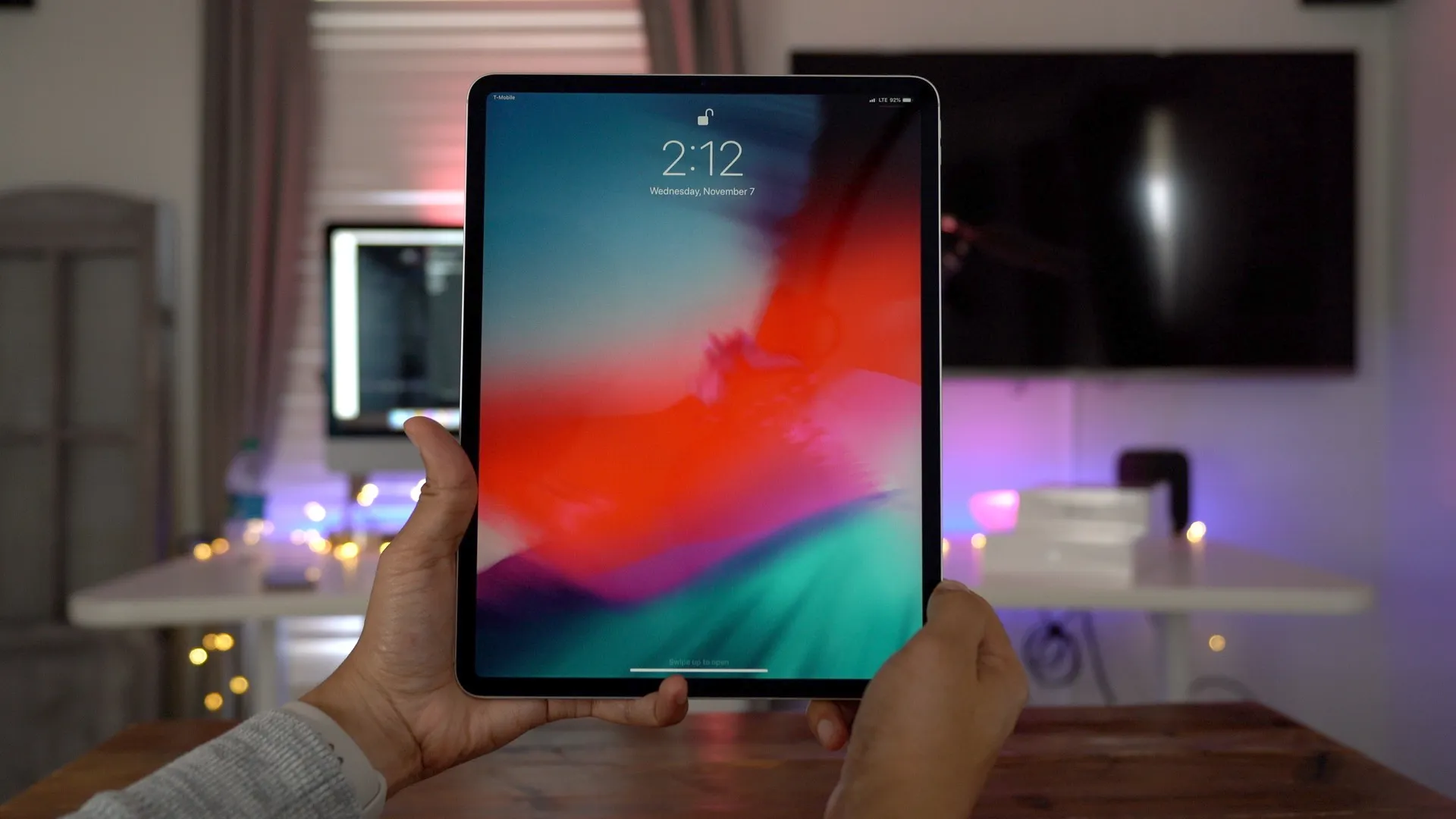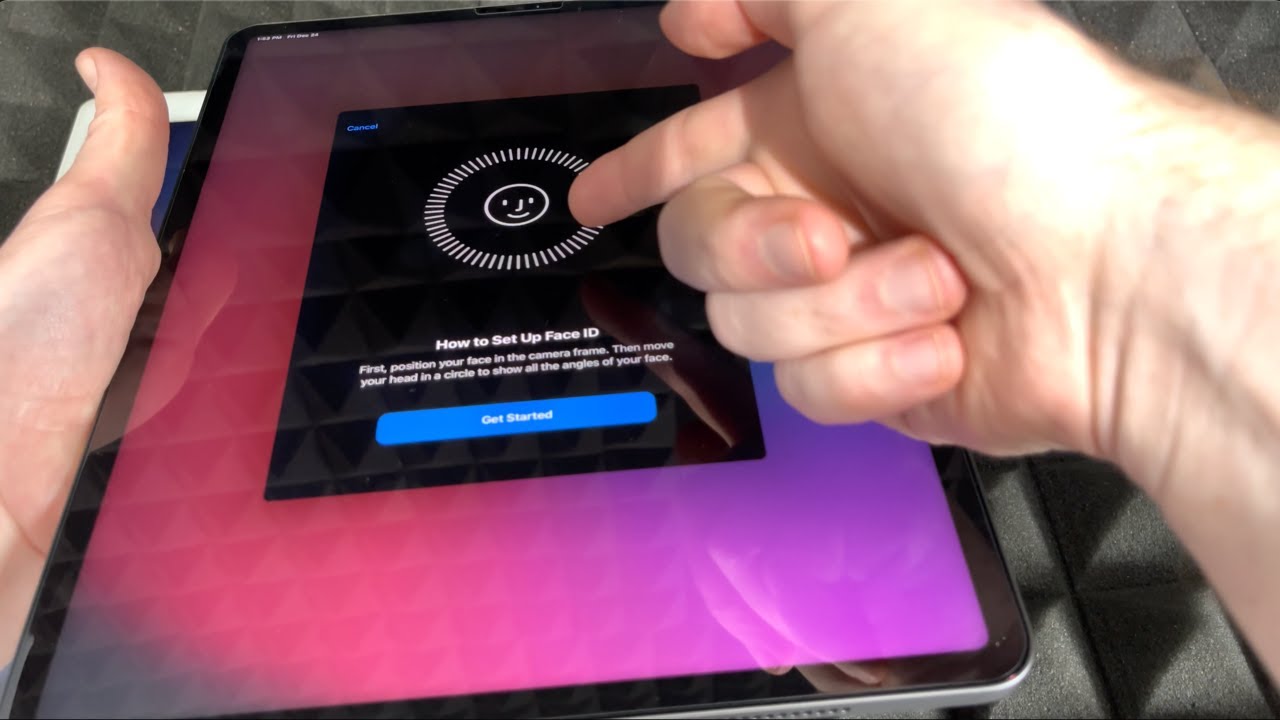Introduction
Face ID, one of Apple’s revolutionary biometric authentication technologies, has become a staple feature in its lineup of premium devices. Initially introduced on the iPhone X, it has since made its way to various iPhone models and even some iPad models. This advanced facial recognition system provides users with a secure and convenient way to unlock their devices, authenticate app purchases, and more.
In this article, we will explore the history and availability of Face ID on iPads. We will delve into the different iPad models that are equipped with this cutting-edge technology, highlighting their unique features and functionalities. Whether you’re considering an iPad upgrade or simply curious about Face ID on iPads, this guide will provide you with all the information you need.
Face ID revolutionizes the way we interact with our devices by replacing the traditional Touch ID fingerprint sensor with a sophisticated facial recognition system. It utilizes a combination of infrared sensors, dot projectors, and neural networks to map and analyze the unique features of a user’s face, creating a highly secure authentication process.
With Face ID, users can effortlessly unlock their iPads simply by looking at the screen. This hands-free approach offers added convenience, particularly in situations where your hands are occupied or wearing gloves. Additionally, Face ID technology continuously adapts to changes in appearance, such as growing a beard, wearing glasses or makeup, making it highly versatile.
Furthermore, Face ID provides robust security measures to protect your personal data. The facial recognition data is securely stored within the device’s secure enclave, ensuring that it is not accessible by third parties or transmitted over the internet. This advanced privacy feature has been a key factor in the widespread adoption of Face ID across Apple’s product lineup.
Now that we have established the significance of Face ID on iPads, let’s explore the exciting journey of how this remarkable technology made its way onto different iPad models. We will discuss the specific models that offer Face ID, along with their unique features and functionalities.
The History of Face ID on iPads
Face ID made its debut on Apple’s iPad lineup with the release of the iPad Pro in 2018. This was a significant milestone for iPad users, as it brought the convenience and security of facial recognition technology to the larger, tablet-sized devices.
The first iPad to feature Face ID was the iPad Pro (3rd generation). With its 12.9-inch Liquid Retina display and powerful A12X Bionic chip, this iPad offered a stunning visual experience and impressive performance. Face ID on the iPad Pro allowed users to effortlessly unlock their device, authenticate app purchases, and securely access sensitive data with just a glance.
Following the success of the iPad Pro (3rd generation), Apple continued to incorporate Face ID into their subsequent iPad models. In 2020, the iPad Pro (4th generation) was introduced, featuring an even more powerful A12Z Bionic chip, dual cameras, and LiDAR technology for enhanced augmented reality experiences. Face ID on the iPad Pro (4th generation) provided users with a seamless and secure authentication process, making it a popular choice among professionals and creative individuals.
Expanding the availability of Face ID beyond the Pro line, Apple introduced the iPad Air (4th generation) in 2020. This sleek and powerful iPad featured a 10.9-inch Liquid Retina display, the A14 Bionic chip, and advanced Touch ID integration within the power button. While the iPad Air (4th generation) offered the convenience of Touch ID, it also supported the use of Face ID, allowing users to choose their preferred biometric authentication method.
In 2021, Apple unveiled the iPad mini (6th generation) with a major redesign and significant performance improvements. The compact yet powerful iPad mini featured an edge-to-edge Liquid Retina display, the A15 Bionic chip, and advanced camera capabilities. Face ID on the iPad mini (6th generation) provided users with a seamless and secure way to unlock their device and access their favorite apps.
While the availability of Face ID on iPads has expanded over the years, it is important to note that not all iPad models offer this feature. The standard iPad and earlier generations of the iPad mini do not have Face ID and still utilize Touch ID for biometric authentication.
As technology continues to advance, it is foreseeable that future iPad models will adopt and refine the Face ID technology, providing users with even more convenience and security.
Now that we have explored the history of Face ID on iPads, let’s dive into the specific iPad models that currently offer this cutting-edge facial recognition technology and discover their unique features and functionalities.
iPad Pro (3rd generation)
The iPad Pro (3rd generation) was the first iPad model to feature Face ID, marking a significant step forward in the evolution of Apple’s tablet lineup. Released in 2018, this iPad introduced a range of impressive features and capabilities.
The standout feature of the iPad Pro (3rd generation) was its stunning Liquid Retina display, measuring 12.9 inches diagonally. This edge-to-edge display offered vibrant colors, sharp details, and ProMotion technology for smooth scrolling and responsiveness. Coupled with the powerful A12X Bionic chip, this iPad delivered unmatched performance and graphics capabilities, making it a compelling choice for multitasking and resource-intensive tasks.
With Face ID on the iPad Pro (3rd generation), users could securely unlock their device simply by looking at the screen. The facial recognition technology was seamlessly integrated into the top bezel, enabling a quick and effortless authentication process. Face ID also allowed users to authenticate app purchases, access password-protected apps, and securely unlock sensitive data stored on the device.
The TrueDepth camera system, utilized by Face ID, also brought exciting features to the iPad Pro (3rd generation). Users could take stunning selfies, make FaceTime video calls with friends and family, and even create personalized Animoji and Memoji. The front-facing camera was also instrumental in augmented reality experiences, enabling accurate spatial mapping and object recognition.
In terms of design, the iPad Pro (3rd generation) showcased a sleek and slim profile. It featured a unibody aluminum chassis, available in Space Gray or Silver, complemented by a flat-edge design reminiscent of the iPhone 5 era. The iPad Pro (3rd generation) also introduced the innovative magnetic connector on the rear, allowing for seamless attachment and charging of the Apple Pencil.
Additional features of the iPad Pro (3rd generation) included a USB-C port for fast data transfer and charging, four powerful speakers for immersive audio, and the Smart Connector for easy connection with accessories like the Smart Keyboard. The iPad Pro (3rd generation) truly elevated the iPad experience and set a high standard for future iterations.
Overall, the iPad Pro (3rd generation) with Face ID offered a compelling combination of advanced facial recognition technology, powerful performance, and a stunning display. It became the go-to choice for creative professionals, photographers, video editors, and those seeking a premium and feature-rich iPad experience.
Next, we will explore the iPad Pro (4th generation), which built upon the foundation laid by its predecessor, introducing even more enhancements and capabilities.
iPad Pro (4th generation)
The iPad Pro (4th generation) continued to build upon the success of its predecessor, introducing new features and enhancements that further elevated the iPad Pro lineup. Released in 2020, this iPad model offered a cutting-edge experience for professionals and creative individuals.
One of the standout features of the iPad Pro (4th generation) was its powerful A12Z Bionic chip, which delivered exceptional performance and graphics capabilities. This, coupled with the stunning 12.9-inch Liquid Retina display, offered an immersive visual experience with vibrant colors and ProMotion technology for smooth and responsive touch interactions.
Like its predecessor, the iPad Pro (4th generation) featured Face ID for a seamless and secure authentication process. By using advanced facial recognition technology, users could unlock their device, authenticate app purchases, and securely access their personal information with a quick glance at the screen.
In addition to Face ID, the iPad Pro (4th generation) boasted a dual-camera system, consisting of a 12-megapixel wide-angle camera and a 10-megapixel ultra-wide-angle camera. This setup provided users with enhanced photography capabilities, allowing them to capture stunning photos and videos. The LiDAR scanner, another notable addition to the iPad Pro (4th generation), enhanced augmented reality experiences by enabling accurate depth mapping and object recognition.
Design-wise, the iPad Pro (4th generation) maintained the sleek and modern aesthetic of its predecessor. It featured a flat-edge design, reminiscent of the iPhone 5 era, and a unibody aluminum chassis. The magnetic connector on the rear allowed for seamless attachment and wireless charging of the Apple Pencil, making it an ideal device for digital artists and note-takers.
In terms of connectivity and versatility, the iPad Pro (4th generation) introduced a USB-C port, allowing for faster data transfer and compatibility with a wide range of peripherals. The device also featured four powerful speakers for immersive audio, FaceTime HD camera for high-quality video calls, and support for Apple’s Magic Keyboard with trackpad for enhanced productivity.
The iPad Pro (4th generation) continued to deliver a premium and feature-rich experience for professionals and creatives. From its powerful performance to its advanced camera system and seamless integration of Face ID, this iPad model cemented its position as a top choice for those seeking a versatile and innovative tablet.
Next, we will explore the iPad Air (4th generation), which introduced Face ID to a wider audience while offering a blend of power and portability.
iPad Air (4th generation)
The iPad Air (4th generation) brought the convenience and security of Face ID to a wider audience, offering a blend of power, portability, and advanced features. Released in 2020, this iPad model offered a compelling option for users looking for a balance between performance and affordability.
With its 10.9-inch Liquid Retina display, the iPad Air (4th generation) offered a vibrant and immersive visual experience. The edge-to-edge display featured True Tone technology, delivering accurate color reproduction, and P3 wide color support for vivid imagery. The A14 Bionic chip, known for its exceptional performance and efficiency, powered this iPad model, making it capable of handling demanding tasks with ease.
While the iPad Air (4th generation) integrated Touch ID into the power button, it also supported the use of Face ID. This provided users with the flexibility to choose their preferred biometric authentication method. Face ID on the iPad Air (4th generation) allowed users to securely unlock their device, authenticate app purchases, and access their personal information without the need to input a passcode.
The iPad Air (4th generation) featured a single 12-megapixel rear camera that delivered impressive photography capabilities. Users could capture detailed photos and 4K videos, thanks to advanced features like Smart HDR and improved image stabilization. The front-facing camera allowed for high-quality video calls and FaceTime conversations, making it easy to connect with friends, family, and colleagues.
In terms of design, the iPad Air (4th generation) took inspiration from the iPad Pro lineup, featuring a slim and lightweight design. The device sported an aluminum body, and it was available in a range of stylish colors, including Space Gray, Silver, Rose Gold, Green, and Sky Blue. The innovative magnetic connector on the side enabled seamless attachment and charging of the second-generation Apple Pencil, providing a natural and intuitive drawing experience.
Connectivity-wise, the iPad Air (4th generation) introduced a USB-C port, allowing for fast data transfer and compatibility with a wide range of accessories. It also featured stereo speakers for immersive audio playback and support for the Magic Keyboard, providing a laptop-like typing experience.
The iPad Air (4th generation) struck a balance between performance, affordability, and advanced features. With the integration of Face ID, users could enjoy a seamless and secure authentication process while taking advantage of the power and versatility that the iPad Air lineup offers.
Next, we will explore the latest addition to the iPad lineup, the iPad mini (6th generation), and its incorporation of Face ID.
iPad mini (6th generation)
The iPad mini (6th generation) introduced Face ID to the compact iPad lineup, delivering an exceptional combination of portability, power, and advanced features. Released in 2021, this iPad model offered a significant redesign and notable enhancements, making it a compelling choice for those seeking a small yet capable tablet.
The iPad mini (6th generation) featured an edge-to-edge 8.3-inch Liquid Retina display, creating an immersive viewing experience with vibrant colors and True Tone technology. Powered by the A15 Bionic chip, this iPad model delivered impressive performance and graphics capabilities, surpassing its predecessor and rivaling larger iPad models.
One of the standout features of the iPad mini (6th generation) was the integration of Face ID. By utilizing advanced facial recognition technology, users could securely unlock their device, authenticate app purchases, and access their personal information with a simple glance at the screen. Face ID on the iPad mini (6th generation) provided a seamless and effortless authentication experience, adding convenience to the compact size.
The iPad mini (6th generation) also boasted an upgraded camera system, featuring a 12-megapixel rear camera with improved low-light performance and 4K video recording. With the powerful camera capabilities, users could capture vibrant photos, record high-quality videos, and even scan documents using the rear camera. The front-facing camera was perfect for FaceTime calls and selfies, allowing users to stay connected and capture memorable moments.
In terms of design, the iPad mini (6th generation) underwent a significant redesign, featuring a sleek and modern aesthetic. It had a flat-edge design, similar to the iPad Pro lineup, and was available in various colors, including Space Gray, Pink, Green, and Sky Blue. The compact size and lightweight nature of the iPad mini (6th generation) made it highly portable, ideal for on-the-go productivity and entertainment.
Connectivity-wise, the iPad mini (6th generation) supported USB-C for faster data transfer and connectivity with a wide range of peripherals. It also featured stereo speakers for immersive audio playback, support for Apple Pencil (2nd generation) for seamless note-taking and drawing, and compatibility with the Magic Keyboard for added versatility.
The iPad mini (6th generation) with Face ID offered a compelling blend of portability, power, and advanced features. Whether for personal entertainment, creative tasks, or professional use, this compact iPad model provided users with a highly capable and convenient tablet experience.
Having explored the iPad mini (6th generation), we have covered all the iPad models that currently feature Face ID. It is remarkable to see how Apple’s advanced facial recognition technology has been integrated into their iPad lineup, offering users a secure and seamless authentication process along with enhanced functionality.
Conclusion
Face ID has brought a new level of convenience and security to Apple’s iPad lineup. From the iPad Pro (3rd and 4th generation) to the iPad Air (4th generation) and the iPad mini (6th generation), Face ID has revolutionized the way users interact with their devices.
With Face ID, users can effortlessly unlock their iPads, authenticate app purchases, and access their personal information with a simple glance at the screen. The advanced facial recognition technology, powered by sophisticated sensors and neural networks, ensures a quick and secure authentication process.
The iPad Pro (3rd and 4th generation) offered a premium tablet experience with their powerful performance, stunning displays, and advanced camera systems. Face ID was seamlessly integrated into these models, providing users with a seamless and secure way to unlock their devices and access their favorite apps.
The iPad Air (4th generation) introduced Face ID to a wider audience, offering a blend of power, affordability, and advanced features. With its A14 Bionic chip and sleek design, the iPad Air (4th generation) became a popular choice for users looking for a versatile and capable tablet.
The iPad mini (6th generation) combined the compact size of the iPad mini lineup with powerful features and a significant redesign. By incorporating Face ID, Apple made the iPad mini (6th generation) even more convenient and secure, making it an ideal choice for those who prioritize portability without compromising performance.
As technology continues to advance, it is likely that Face ID and other biometric authentication methods will become even more prevalent in future iPad models. Apple’s commitment to innovation and user experience ensures that their devices will continue to evolve and adapt to the needs and expectations of users.
Whether you’re a professional, a creative individual, or a casual user, Face ID on iPads provides a seamless and secure way to unlock your device and access your favorite features. By combining convenience, security, and stylish design, Face ID-equipped iPads have become a game-changer in the tablet industry.
So, whether you opt for the larger and more powerful iPad Pro, the versatile and affordable iPad Air, or the compact and portable iPad mini, you can enjoy the benefits of Face ID technology in an innovative and user-friendly package.

























